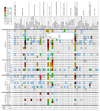The Mouse Tumor Biology database
- PMID: 18432250
- PMCID: PMC2574871
- DOI: 10.1038/nrc2390
The Mouse Tumor Biology database
Abstract
The laboratory mouse has long been an important tool in the study of the biology and genetics of human cancer. With the advent of genetic engineering techniques, DNA microarray analyses, tissue arrays and other large-scale, high-throughput data generating methods, the amount of data available for mouse models of cancer is growing exponentially. Tools to integrate, locate and visualize these data are crucial to aid researchers in their investigations. The Mouse Tumor Biology database (http://tumor.informatics.jax.org) seeks to address that need.
Figures





References
-
- Lifsted T, et al. Identification of inbred mouse strains harboring genetic modifiers of mammary tumor age of onset and metastatic progression. Int. J. Cancer. 1998;77:640–644. - PubMed
-
- Demant P. Cancer susceptibility in the mouse: genetics, biology and implications for human cancer. Nature Rev. Genet. 2003;4:721–734. - PubMed
Publication types
MeSH terms
Grants and funding
LinkOut - more resources
Full Text Sources
Other Literature Sources
Molecular Biology Databases

